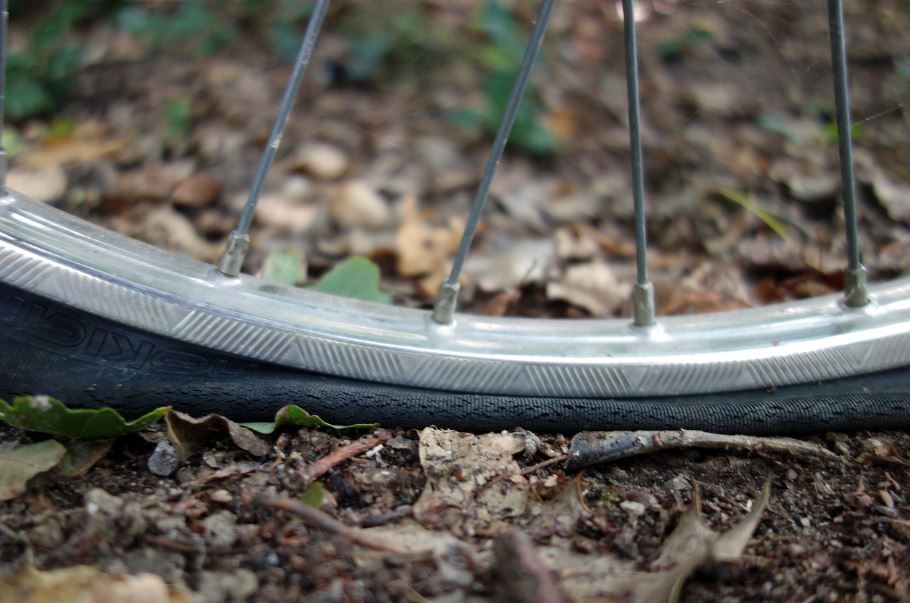We’ve all been there – a flat tire during a bike ride can quickly put a damper on your plans. But what if there’s a quick and easy solution to get you back on the road in no time?
You might be wondering if you can use Fix A Flat on a bike tire – afterall, it’s a tire sealant designed to temporarily seal punctures and reinflate the tire.
Turns out, this magical elixir is not the knight in shining armor you thought it was.
You cannot use Fix A Flat on bike tires, it’s only meant for automobile tires.
In this article, I’ll talk about why you shouldn’t use Fix-a-Flat on a bike tire and what you can do instead if you get a flat tire on the road.
How Does Fix-a-Flat Work?
Fix-a-Flat is a brand of emergency tire repair sealant that is designed to temporarily seal punctures in tires, allowing drivers to reach a nearby service station for proper repair.
Fix-a-Flat typically comes in an aerosol can or a similar container, and it contains a combination of sealant, propellant, and other additives.

Also Read: Best tubeless rim tape
When you attach the Fix-a-Flat can to the valve stem of the flat tire and release the sealant, several things happen:
- The sealant is pushed into the tire through the valve stem. The pressure from the propellant in the can helps to force the sealant into the puncture.
- As the sealant enters the tire, it flows toward the puncture and comes into contact with the air leaking out. The sealant is designed to quickly react with the air and form a temporary seal.
- The sealant not only seals the puncture but also coats the inner surface of the tire. This coating helps to prevent air leakage through other potential small leaks or porous areas in the tire.
- The propellant in the can creates pressure, which aids in distributing the sealant evenly throughout the tire and covers a sufficient area to effectively seal it.
Why Can’t You Use Fix-a-Flat On Bike Tires?
You can’t use Fix-a-Flat on bike tires because it is specifically formulated for automobile tires. The composition of the mixture is not intended for use with tires that have tubes, such as those found on bikes, lawnmowers, and golf carts.

When applied to bike tires, Fix-a-Flat can potentially cause complications.
It can lead to the valve stem becoming clogged from the inside, making it challenging to add air or other sealants since it seals off the air entry point.
Also Read: 2.6 vs 2.4 MTB tires
Plus, the directions for use explicitly advise against using it on motorcycle or bicycle tires due to the potential hazards and the risk of loss of control.
Although some sources suggest that Fix-a-Flat can be used on bike tires with inner tubes and small punctures, it is still not recommended due to the potential risks and issues.
Back in the days Fix-a-Flat had a sealant made just for bikes – Fix-a-Flat Bikes Only, unfortunately they no longer make them anymore.
How To Repair Flat Tires On The Road?
There are two ways I recommend doing this – Slime sealant or patch / replace the tube.
Slime Sealant
Slime is a liquid sealant that can be used to repair punctures in bike tubes or tubeless tires.
Also Read: Bike tire not taking air
It’s a quick and easy solution for minor punctures, allowing you to get back on the road in no time. Here’s how to use slime to repair a flat bike tire:
- First, you’ll need to find the source of the leak. Listen for escaping air.
- Next, remove the valve core from the valve stem. This will allow you to inject the slime directly into the tube or tire.
- Attach the slime bottle to the valve stem and squeeze the recommended amount of slime into the tube or tire. The slime will spread throughout the interior, sealing any punctures it encounters.
- Put the valve core back into the valve stem, ensuring it’s tight and secure.
- Pump air back into the tire, making sure to inflate it to the recommended pressure.
- Spin the wheel or ride your bike for a short distance to evenly distribute the slime inside the tire. This will ensure that the puncture is fully sealed.
Unlike patching methods, Slime sealant doesn’t require drying time. It can effectively plug holes for up to two years!
Patch Or Replace The Tube
To do this, you need a well-stocked repair kit. An on-the-go repair kit typically includes a spare tube, tire levers, patches, and a mini pump or CO2 inflator.
You’ll also need a multi-tool with various wrench sizes and screwdrivers.
Here’s how you patch it:
- Remove the Tire: Use the tire levers to carefully remove the tire from the rim, exposing the tube.
- Locate the Hole: Inflate the tube slightly and listen or feel for air escaping to locate the puncture.
- Prepare the Tube: Roughen the area around the puncture using the sandpaper from the patch kit. Apply a thin layer of vulcanizing solution and let it dry for a few minutes.
- Apply the Patch: Peel the backing off the patch and firmly press it onto the prepared area, ensuring good adhesion. Hold it in place for a few minutes to allow the glue to bond.
- Reinstall the Tube and Tire: Carefully insert the repaired tube back into the tire and reinstall the tire onto the rim. Inflate the tire to the recommended pressure.
If you need to replace the tube you have to invert the bike. However, if you have hydraulic brakes, it’s advisable to position the bike in a way that doesn’t require flipping it upside down.
The hydraulic fluid in the brake lines can potentially leak or cause air bubbles if the bike is inverted.

